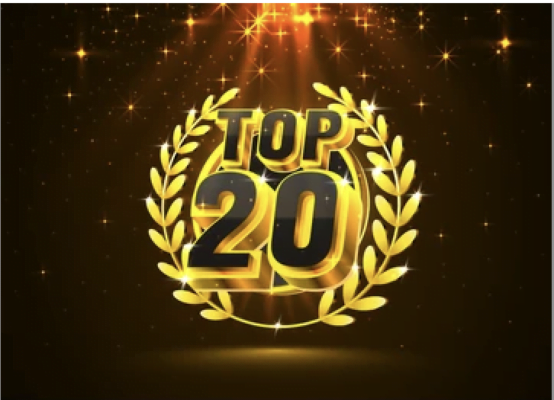
Disappearing media
This is the 199th edition of SHuSH, the official newsletter of the Sutherland House Inc.

As we’ve often noted at SHuSH, it’s difficult to find reliable information on the Canadian publishing industry, and especially the Canadian independent publishing industry. Most independents are privately owned and under no obligation to release their sales results to anyone. Except when they want grants.
The Canada Book Fund is unique among Canadian granting agencies in that it pays out on the basis of sales of Canadian-authored books. As a result, its grants are an imperfect but reasonable proxy for the relative size of Canadian-owned firms. When I started in publishing, this information was routinely available on the fund’s website. For the last three or four years, it has been missing for mysterious reasons. Friends of SHuSH have managed to get us the latest data.
I’m going to give you the top twenty English-language publishers with the amounts they received in 2022-2023 and the +/- difference between the most recent year and 2018-19.
A few notes.
The formula of the Canada Book Fund is quite complex and not every book by every publisher is eligible for the program. As a rule of thumb, multiply the book fund amount by twelve and you’ll get a rough approximation of the annual revenues of a publisher. When I say rough, I mean very rough: in some instances, the actual revenue might be less than 10x and in others more than 15x. Here, by way of example, are three ways the fund is a fun-house mirror:
Numbers 1 & 2, Anansi/Groundwood and ECW/Annick, are separately incorporated publishing imprints under single ownership. Anansi and ECW are adult publishers; Groundwood and Annick are children’s publishers. The children’s unit is the larger in both instances. Anansi and ECW, if ranked alone, would be in the lower half of the top twenty.
That shows the strength of children’s publishers on this list: in addition to Annick and Groundwood, KidsCan, Inhabit, Firefly, Orca, and OwlKids are all exclusively or primarily of that ilk, while Fitzhenry & Whiteside, Red Deer Press, and Greystone are mixed kids/adults publishers. That’s nine of twenty.
Eleven of the twenty are educational or academic: Emond Montgomery, CCI, Weigl, Portage & Main, Broadview, Crabtree, Scolab, CSP (Canadian Scholars and Women’s Press), University of Toronto Press, University of British Columbia Press, McGill-Queens University Press.
So there isn’t a single standalone adult publisher in our list of top twenty Canadian independent publishers, although, as I’ve said, ECW and House of Anansi could make the list on their own. I suspect Greystone would as well if you stripped out its children’s list.
English Canada does have a number of fine publishers of adult books: Arsenal Pulp Press, Biblioasis, Coach House, Cormorant, Douglas & McIntyre, Goose Lane, Harbour, Lorimer, New Society, and so on. But they are all in the range of $100,000-$175,000 range. (Sutherland House is a whole rung down among the five-figure publishers, but we’re gaining!)
To put the scale of those adult publishers in perspective, it would take about six or eight of them combined to make one ECW/Annick, and it would take two or three ECW/Annicks to make one of the bigger independents we lost at the start of the century—Stoddart/General, McClelland & Stewart, Key Porter, Douglas & McIntyre.
There has been some big movement on the list by individual publishers over the last five years. Greystone has had a fantastic run, perhaps much better than shows here because its huge international bestseller, Peter Wohlleben’s The Hidden Life of Trees, written by a German and translated by an American, wouldn’t qualify for the Canada Book Fund. A couple of the educationals—Crabtree and Weigle—have seen significant declines. Rubicon Publishing, a good-sized education publisher which ranked in the middle of the 2018-2019 list, was bought by a New Jersey-based firm and no longer qualifies for the fund. Dundurn Press was in the middle of the ranking in 2018-2019 but made a deliberate choice to reorganize its business and is just outside the top-twenty at present.
In case you missed it yesterday, the Wall Street Journal has the latest on Simon & Schuster. The venerable publisher’s parent-company, Paramount Global, tried to sell it to Penguin Random House in 2020, only to get shot down by the US Department of Justice on antitrust grounds in 2022. The combined entity would have had 27% of the trade book market in the US and a much larger share of the market for top-selling titles.
S&S is back on the auction block and there are two bidders: HarperCollins and the private-equity firm, Kohlberg, Kravis Roberts & Co. (KKR). Second-round bids are due in July. The company should be in new hands by autumn.
This is how we saw things unfolding in SHuSH 171, “This Settles Nothing.” It is not a happy outcome for S&S.
My assessment of the KKR option stands (abbreviated):
KKR’s media division is overseen by Richard Sarnoff, a Princeton-educated great-nephew of David Sarnoff, who was chairman of RCA at the time when RCA loomed over American business like Google. Richard is a former Bertelsmann (owner of PRH) executive. He helped arrange its purchase of Random House from S.I. Newhouse’s Advance Publications back in 1998 and joined KKR as a senior advisor for media investments in 2011. He has a thing for publishing assets….
If KKR acquires S&S, it will again do what private equity does: shed costs, paint the walls, and convince some sucker to overpay for it down the road. The New Republicpredicts “absolute devastation and wholesale job loss” if S&S falls to private equity.
The one good thing about a private-equity solution is that S&S would remain an independent player in publishing—more competition. At least, it would remain independent until it is flipped down the road, perhaps to another publisher at a higher price.
I speculated in that same piece that S&S is more likely to land with another publisher than with private equity. During the trial over the Penguin Random House deal, HarperCollins and Hachette both indicated a willingness to bid for S&S should it come back on the market. Judge Pan’s decision left the door open to a less gigantic merger than PRH/S&S.
HarperCollins/S&S together would have about 17 percent of the US trade market, making it almost as large as PRH. You can read that as enhancing competition: suddenly, PRH would have a near-equal in the US market. On the other hand, there would be one less major player on the US scene, making a Big Four of the Big Five (PRH, S&S, HarperCollins, Hachette, Macmillan), which diminishes competition.
I can’t imagine the people at S&S are excited about either option. Who would you choose between a bunch of private equity bros and Rupert Murdoch’s NewsCorp?
Both buyers will need to look for cost savings and efficiencies in the operations of the newly combined entities in order to cover the huge purchase price of S&S (just as PRH was planning to do). It might not mean wholesale devastation, but it will be perilous for author advances, publishing jobs, and the breadth, depth, and diversity of stories whoever winds up in charge.
It must be emphasized that the outlook is worse for Canada. Just three multinational firms dominate our market (Macmillan and Hachette do not operate here). Our government was silent on the Canadian part of the PRH/S&S deal, never mind that it threatened to leave one firm with control of well over 50 percent of our book trade (its biggest competitor would have been HarperCollins at 11 percent).
If HarperCollins comes out on top, we’ll be down to a foreign-owned duopoly. And what a duopoly: Penguin Random House, owned by a bunch of Germans with intergenerational tensions and Nazi ancestry; HarperCollins/S&S, owned by a 92-year-old Trump supporter with a dysfunctional family of his own. Together, they’ll publish the vast majority of adult trade books sold in Canada.
Will that be sufficient to get Ottawa’s attention?
The Globe & Mail excerpted Dr. Elaine Chin’s We Are Not Okay last weekend. I admit to being fascinated by the knock-on effects of the pandemic—to our physical and mental health, social dynamics, economy, and politics.
Things keep popping up, like the fact that a bunch of us are likely brain-damaged from COVID:
Using MRI imaging, the UK Biobank study has discovered brain changes in patients who have contracted COVID compared with non-vaccinated/non-infected controls. They include brain atrophy (tissue shrinking), loss of grey matter (which controls movement, memory and emotions), and overall cognitive decline. This new study confirms the effect of inflammation on the brains of COVID patients, even when their infections were mild.
In one study, researchers in Munich examined the brains of patients who passed away from non-COVID causes but were documented to have had COVID when they were alive. They discovered that 12 of 20 of these individuals had marked accumulation of the SARS-CoV-2 spike protein in the skull-meninges and brain tissue, which was not found in control subjects. It’s notable that only the spike protein and not other parts of the virus were found in their brain tissues.
Animal models show these spike proteins cause brain cell injury and persistent inflammation.
This finding gives us a better understanding of why so many people, even after a mild bout of COVID, continue to experience neurological symptoms even after the apparent recovery of their COVID infection.
The implication of brain damage on a subset of the population is significant for the workplace and future ability to function with activities of daily living.
Which leads to our weekly reminder that a newsletter like SHuSH is a lot of work. We don’t charge for it or present advertising or ask for donations, but that doesn’t mean we wouldn’t appreciate a little support. The best way you could help keep us going is to subscribe to our Sutherland Quarterly.

Dr. Chin’s book is the third edition of Sutherland Quarterly, now available for order. Here’s the description:
COVID-19 made almost five million Canadians sick, put hundreds of thousands in hospital, and claimed over 50,000 lives. The numbers are startling yet they don’t begin to capture the enormity of what we endured in our three-year ordeal, nor the fact that it’s not over. Many people are still grieving loved ones, many survivors are still grappling with long covid, and many continue to experience the pandemic as never-ending trauma. General healthcare has deteriorated and waiting lists have swelled even for urgent surgeries. Rates of respiratory and heart disease and strokes are up. Years of involuntary confinement, isolation, and boredom have contributed to a “shadow pandemic” of alcohol, cannabis, and opioid abuse, especially among the young. Rage is everywhere, the number of hate crimes has spiked, along with fears of civil disorder. Three million workers lost their jobs and a majority of small businesses either failed or weathered near-death experiences. Our workplaces, schools, and downtowns were hollowed out and may never entirely recover.
As year four begins, people are still dying at alarming rates and we are just beginning to learn of the myriad knock-on effects of the pandemic. In this important and galvanizing book, Dr. Elaine Chin argues that a full audit of the personal and social consequences of COVID-19 is the indispensable first step to a full recovery for individuals, families, and communities.
Launched last fall, Sutherland Quarterly is a new series of captivating essays on current affairs by some of Canada’s best writers. Each essay will be published as a stand-alone book and sold at retail in the usual manner; the essays will also be available (at a preferred price) by annual subscription. We Are Not Okay will hit stores this week at $19.95 (plus HST); the subscription price is 20 percent off the cover price or $67.99 (including HST). I hope you’ll consider subscribing.
Also, we are open to submissions.

This is the 199th edition of SHuSH, the official newsletter of the Sutherland House Inc.

There was an interesting piece in the New York Times a week or so ago about James Daunt (above), the incoming chief executive of Barnes & Noble, the most important bookstore chain in the English-speaking world. It didn’t quite get to the nub of the matter. Barnes & Noble has

The world of non-fiction from Sutherland House ( and Beyond )